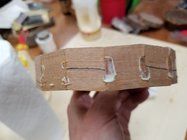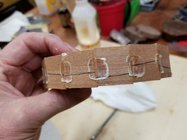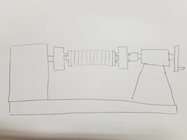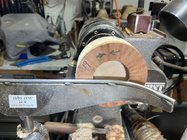Russ Braun
TOTW Team
I guess your wife doesn't read your posts on this forum!Im a 43 year married man Steve, not easily annoyed, haha!!
I just invited her as a guestI guess your wife doesn't read your posts on this forum!
For 43 years, she’s been shaking her head! 42 years ago, she gave up all hope that I might change! It’s hopeless, haha!!I just invited her as a guest
Steve, with those learning and new to segmenting, you have to read between the lines. You can have a gap with a perfect set up. It may be just on one side. in your illustration, the segments are proud. No one glues up rings that way. They flatten them down. These errors are from blade alignment issues. It is necessary to teach alternating the segments correctly. You can also have different gaps on opposite sides of a ring. I usually can assess a problem from a pic. You can also have a curved cut. In that case the ring fits perfectly in the center but has a gap at the outside. That comes from setting the blade height just above the segment height and the blade not parallel to the track. A simple thing like debris between the strip and fence can cause a nightmare. Most segmenters not just beginners do not know this stuff. To them, everything is about the “segment angle”. It either works or it doesn't.Read the words, he is talking about segment angle. Shop time for me too......
Jerry,Steve, with those learning and new to segmenting, you have to read between the lines. You can have a gap with a perfect set up. It may be just on one side. in your illustration, the segments are proud. No one glues up rings that way. They flatten them down. These errors are from blade alignment issues. It is necessary to teach alternating the segments correctly. You can also have different gaps on opposite sides of a ring. I usually can assess a problem from a pic. You can also have a curved cut. In that case the ring fits perfectly in the center but has a gap at the outside. That comes from setting the blade height just above the segment height and the blade not parallel to the track. A simple thing like debris between the strip and fence can cause a nightmare. Most segmenters not just beginners do not know this stuff. To them, everything is about the “segment angle”. It either works or it doesn't.
Brian was relating his experience in is own words, not joining the fray.

Russ, I'd be careful with this setup. Maybe your sander is set up different to mine. Mine has 2 clamping rollers that hold the workpiece down that are about 3" apart with the sanding drum between them. If your small ring is smaller than 3" it will still be unsupported when the drum is sanding it. It is obviously working for you, perhaps the rings are big enough to be under at least one roller all the time?I use the larger rings to contain the smaller ones as often as possible when drum sanding. This same large ring carried all the smaller rings. It might be a hair thinner than the rest….shhhhh!! It doesn’t matter with this build up, lol!!
Hi Jerry, your second sentence is actually not correct. You may also making assumptions about me that aren't correct. I is a engoneer. I spend all day in the world of designing and developing engine and aftertreatment systems. It always starts with theory and analysis. The analysis software these days is nothing short of astounding in what it can do. But you are right, they never work straight off the analysis. You have to prototype and test and iterate.A simple zigzag will go together naturally. Anything else will not. I have spent my entire life in the theoretical world. What makes life interesting is when you strap a parachute on a student and jump into the cockpit, their world, they will take you into places that our personal “theory“ is alien to. We assume too much. Over the years I have learned to value of being wrong as much as being right. I have never learned a thing by being right. They have taught me.
Yes, I can flat spin an airplane upside down. I am still alive because I pick the right airplane. Beginning segmenters have taken me places I did not know existed. Bless um.
Talk about random thoughts and verbating.
 WWWW
WWWW
It seems to work Steve, w/o issue. I did have a dip in one of the maple pieces but that could have come from an initial run that I ran them solo. I do check things before glue up for issues.Russ, I'd be careful with this setup. Maybe your sander is set up different to mine. Mine has 2 clamping rollers that hold the workpiece down that are about 3" apart with the sanding drum between them. If your small ring is smaller than 3" it will still be unsupported when the drum is sanding it. It is obviously working for you, perhaps the rings are big enough to be under at least one roller all the time?
I know nothing about you. I am sharing my experience with beginners. I also can make perfect rings. As I said before, I demo’d making a 2 layer feature ring with trapezoid, and leaning segments with different woods where every blade angle was different. I did not measure a single angle or dimension and it went together perfectly. You can try that and I will give you pointers along the way.Hi Jerry, your second sentence is actually not correct. You may also making assumptions about me that aren't correct. I is a engoneer. I spend all day in the world of designing and developing engine and aftertreatment systems. It always starts with theory and analysis. The analysis software these days is nothing short of astounding in what it can do. But you are right, they never work straight off the analysis. You have to prototype and test and iterate.
I've already made several rings with intentional error built into the saw blade angle for other non-believers. I wouldn't be making this claim if I hadn't done that. I couldn't find any in my shop, so quickly made one especially for you!!
This has 3 deg blade error which I think is large, even for a beginner. I can eyeball it closer than that.
I drew your lines on it on the top and side of the strip and then shook all the parts up in a bucket to defuzz and randomly assembled them. Glue up assembly was no issue. The joints are all still vertical, just like my picture. This goes together naturally, just like a zig zag, because the vertical edges will naturally come together. The pieces don't try and pop up or down, they are quite happy to be in equilibrium and look identical to my sketch that you are questioning. I didn't do anything special, just glued it and band clamped it the same as always. 15 seconds to assemble tops, with no issues. It sits flat on a bench surface The only interesting thing to me is that random can include 4 or 5 pieces in a row in the same orientation. Great for this demo.
Here are the pics. First one is a section that has a zigzag and it looks just like my zig zag sketch. Second is a section that has 5 segments in a row that aren't zig zags. Also looks just like my random sketch.
View attachment 56868
View attachment 56871
Time to put your money where your mouth is Jerry. Go try it. It works.
Would it help if you shorten the dowel, so it is a little shorter than the stack, at least at the tail stock end. Then you could add clamping pressure from the lathe directly to the rings.I had more of a challenge with the “red-neck”….sorry, had to go there, haha! Lots of slippage. I tapered so stir sticks as wedges and that pretty much broke the seal with the HM glue. What I found is the dowel was pretty smooth, not a lot of bond there to start with. BTW, electrical tape helped a tiny bit. I got through this with a little more HM glue and no a quit mentality.
Michael, there will be some carving to clean this neck up. Micromotor and a rough burr, files and sandpaper. Thank you Malcolm Tibbetts….again. I do want to say right now that this swap piece does not have Perone’s Disease! The recipient need not be concerned!!That’s a cool system for the neck! I wondered how you were going to bend it. I assumed you would make the rings large and then carve them to size…..but of course not. Just bevel each ring. Awesome! Thanks for showing that—it makes the construction of a lot of pieces a bit more clear. Good stuff Russ!
Well I thought about that Steve and I came up with blanks. I’ve got the tailstock/ live end holding the dowel, other end in a chuck. Sooo, I need a clamping mechanism. I could have turned the end of the dowel down to fit my Jacobs Chuck, shortened the dowel and then crank the tailstock up to squeeze the stack….then tighten the Jacobs Chuck on to the dowel; maybe use a piece of wood between the JC and the stack to protect the segmented rings. Next time!Would it help if you shorten the dowel, so it is a little shorter than the stack, at least at the tail stock end. Then you could add clamping pressure from the lathe directly to the rings.
Another version - how about a chuck at each end with the dowel just protruding a short amount. Snug each end of the dowel in the chucks, clamp the tailstock and then tighten the chucks.Well I thought about that Steve and I came up with blanks. I’ve got the tailstock/ live end holding the dowel, other end in a chuck. Sooo, I need a clamping mechanism. I could have turned the end of the dowel down to fit my Jacobs Chuck, shortened the dowel and then crank the tailstock up to squeeze the stack….then tighten the Jacobs Chuck on to the dowel; maybe use a piece of wood between the JC and the stack to protect the segmented rings. Next time!

A good rasp will make the curves fair. Rotary tools will give it the pock. A random orbital sander will gently top it off. Kutzall makes the best rasps for this. Don’t get the coarse.Michael, there will be some carving to clean this neck up. Micromotor and a rough burr, files and sandpaper. Thank you Malcolm Tibbetts….again. I do want to say right now that this swap piece does not have Perone’s Disease! The recipient need not be concerned!!
What??? a chuck on each end, lol!!Another version - how about a chuck at each end with the dowel just protruding a short amount. Snug each end of the dowel in the chucks, clamp the tailstock and then tighten the chucks.
View attachment 57026
Haha, I knew there was something I needed to buy for this follow-along project to come together, Jerry!! I am interested in a top-quality rasp!! If you say don't get the coarse, of course I want to see that one now, lol!! There is some history behind that statement.....ask Dad!!A good rasp will make the curves fair. Rotary tools will give it the pock. A random orbital sander will gently top it off. Kutzall makes the best rasps for this. Don’t get the coarse.

What??? a chuck on each end, lol!!
Funny how the brain works….especially with no-brainer issues…haha!!Don't laugh ....

lose your BabeBot? Works great for me.Ahhh, stir sticks come in handy again! I love these and bamboo skewers! They are great disposable handy helpers! I ran two beads of extend glue down the top of the segments and started spreading between the segments. Ughh!! I ran two more beads down the row and voila, enough glue to make this technique manageable. Woohoo!!
